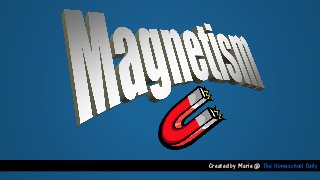Magnetism
•
0 likes•5,024 views
DOWNLOAD PDF at The Homeschool Daily (.com) under slideshows http://thehomeschooldaily.com/slideshows/ This slideshow features the properties of magnets. Magnets are used in technology that we use everyday. Some of the terms featured in this slideshow are magnet, poles, repel, and attract. Check it out to discover some of the characteristics of magnets! Happy Learning!
Report
Share
Report
Share

Recommended
Recommended
More Related Content
More from Marie
More from Marie (6)
Recently uploaded
Antibiotics are medicines that fight infections caused by bacteria in humans and animals by either killing the bacteria or making it difficult for the bacteria to grow and multiply. Bacteria are germsABHISHEK ANTIBIOTICS PPT MICROBIOLOGY // USES OF ANTIOBIOTICS TYPES OF ANTIB...

ABHISHEK ANTIBIOTICS PPT MICROBIOLOGY // USES OF ANTIOBIOTICS TYPES OF ANTIB...ABHISHEK SONI NIMT INSTITUTE OF MEDICAL AND PARAMEDCIAL SCIENCES , GOVT PG COLLEGE NOIDA
Recently uploaded (20)
COMPOSTING : types of compost, merits and demerits

COMPOSTING : types of compost, merits and demerits
Understanding Partial Differential Equations: Types and Solution Methods

Understanding Partial Differential Equations: Types and Solution Methods
GBSN - Microbiology (Unit 3)Defense Mechanism of the body 

GBSN - Microbiology (Unit 3)Defense Mechanism of the body
Human & Veterinary Respiratory Physilogy_DR.E.Muralinath_Associate Professor....

Human & Veterinary Respiratory Physilogy_DR.E.Muralinath_Associate Professor....
development of diagnostic enzyme assay to detect leuser virus

development of diagnostic enzyme assay to detect leuser virus
LUNULARIA -features, morphology, anatomy ,reproduction etc.

LUNULARIA -features, morphology, anatomy ,reproduction etc.
Thyroid Physiology_Dr.E. Muralinath_ Associate Professor

Thyroid Physiology_Dr.E. Muralinath_ Associate Professor
Use of mutants in understanding seedling development.pptx

Use of mutants in understanding seedling development.pptx
Efficient spin-up of Earth System Models usingsequence acceleration

Efficient spin-up of Earth System Models usingsequence acceleration
Site specific recombination and transposition.........pdf

Site specific recombination and transposition.........pdf
FAIRSpectra - Enabling the FAIRification of Spectroscopy and Spectrometry

FAIRSpectra - Enabling the FAIRification of Spectroscopy and Spectrometry
GBSN - Biochemistry (Unit 2) Basic concept of organic chemistry 

GBSN - Biochemistry (Unit 2) Basic concept of organic chemistry
Gwalior ❤CALL GIRL 84099*07087 ❤CALL GIRLS IN Gwalior ESCORT SERVICE❤CALL GIRL

Gwalior ❤CALL GIRL 84099*07087 ❤CALL GIRLS IN Gwalior ESCORT SERVICE❤CALL GIRL
ABHISHEK ANTIBIOTICS PPT MICROBIOLOGY // USES OF ANTIOBIOTICS TYPES OF ANTIB...

ABHISHEK ANTIBIOTICS PPT MICROBIOLOGY // USES OF ANTIOBIOTICS TYPES OF ANTIB...
Cot curve, melting temperature, unique and repetitive DNA

Cot curve, melting temperature, unique and repetitive DNA
Magnetism
- 1. Created by Marie @ The Homeschool Daily
- 2. Magnet A stone or a piece of metal that attracts some other metal. Attract To pull towards each other. Repel To push away from each other. Poles The ends of a magnet.
- 3. The first magnets were called Lodestones. Lodestones are natural magnets that are made of a mineral called magnetite. Long ago, these lodestones were thought to have magic powers. Their power is called magnetic force. Lodestones
- 4. horseshoe magnet bar magnet doughnut magnet wand magnet Types of Magnets
- 5. They are used to slow down roller coasters and subways. Magnets are in most electronic devices, in fact, anything that has a motor uses a magnet. What are some uses for magnets?
- 6. They can also repel other magnets. What are the characteristics of magnets?
- 7. Every magnet has at least one north pole and one south pole. What about the poles? The blue end of a magnet is usually the south pole. The red end of a magnet is usually the north pole.
- 8. These forces are strongest at the ends of the magnets. The two ends of a magnet are known as the north pole and the south pole. When two magnets are close, they create pushing or pulling forces on one another.
- 9. If you try to put two magnets together with the same poles pointing towards one another, the magnets will push away from each other. We say they repel each other. In this picture two north poles are pushing away from each other (repelling each other). Same poles REPEL
- 10. If you put two magnets together with different poles pointing towards one another, the magnets will pull towards each other. We say they attract each other. In this picture a north and a south pole are pulling towards each other (attracting each other). Different poles ATTRACT
- 11. We know that “like” poles repel each other and that “opposite” poles attract each other. They do this because there is a FORCE between them. What did we find out?
- 12. Magnets can attract other magnets, but they can also attract magnetic materials. Magnetic materials are always metals, but only a few metals are magnetic: IRON NICKEL COBALT Did you know?
- 14. What is Magnetic? Home Lab It is your turn to investigate magnetism! Ask your parent or teacher to help you find a magnet. Using your magnet, try to find at least 8 things that are magnetic. Find 8 things that are not magnetic.
- 15. Created by Marie @ The Homeschool Daily Blessed is the man that walketh not in the counsel of the ungodly, nor standeth in the way of sinners, nor sitteth in the seat of the scornful. Psalm 1:1
